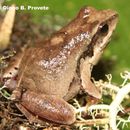en
names in breadcrumbs


Die Pfeiffrösche (Leptodactylidae im engeren Sinn) sind eine neuweltlich verbreitete Familie der Froschlurche (Anura). Bis vor einiger Zeit wurde diese wesentlich weiter gefasst. Dabei handelte es sich allerdings um ein paraphyletisches Sammeltaxon, das im Deutschen unter den Namen Südfrösche oder auch Pfeiffrösche bekannt war. Die meisten dieser ehemals weit über 1000 Arten wurden nach umfassenden Revisionen in anderen Familien klassifiziert (vgl. Ceratophryidae, Cycloramphidae, Alsodidae, Eleutherodactylidae, Telmatobiidae und Craugastoridae).
Die verbliebenen 13 Gattungen der Leptodactylidae im engeren Sinn kommen mit mehr als 200 Arten vom äußersten Süden von Texas bis ins südliche Brasilien vor. Die bei weitem artenreichste Gattung sind die Echten Pfeiffrösche (Leptodactylus) mit 74 Arten. Ihre Vertreter verfügen oft über laute, pfeifende Rufe. Bei der Fortpflanzung wird der Laich in ein selbst fabriziertes Schaumnest gelegt. Dies geschieht meistens in einem Gewässer oder in Gewässernähe, beim brasilianischen Marmor-Pfeiffrosch (Adenomera marmorata, Syn. Leptodactylus marmoratus) wird das Schaumgelege jedoch im Erdboden vergraben, wo die Kaulquappen auch ihre gesamte Entwicklung durchlaufen.
Die Familie umfasst drei Unterfamilien mit 13 Gattungen mit insgesamt 206 Arten.
(Bearbeitungsstand: 4. Januar 2021)
Unterfamilie Leptodactylinae Werner 1896 (103Arten) Stand: 23. Juni 2020
Die Gattung Lithodytes wurde weitgehend aufgelöst und auf mehrere andere Taxa verteilt. Zumindest die Art Lithodytes lineatus wird in manchen Übersichten aber als valide betrachtet (sonst als Synonym von Leptodactylus lineatus).
Unterfamilie Paratelmatobiinae Ohler & Dubois, 2012 (13 Arten)
Unterfamilie Leiuperinae Bonaparte, 1850 (100 Arten) Stand: 23. Juni 2020
Die Pfeiffrösche (Leptodactylidae im engeren Sinn) sind eine neuweltlich verbreitete Familie der Froschlurche (Anura). Bis vor einiger Zeit wurde diese wesentlich weiter gefasst. Dabei handelte es sich allerdings um ein paraphyletisches Sammeltaxon, das im Deutschen unter den Namen Südfrösche oder auch Pfeiffrösche bekannt war. Die meisten dieser ehemals weit über 1000 Arten wurden nach umfassenden Revisionen in anderen Familien klassifiziert (vgl. Ceratophryidae, Cycloramphidae, Alsodidae, Eleutherodactylidae, Telmatobiidae und Craugastoridae).
Die verbliebenen 13 Gattungen der Leptodactylidae im engeren Sinn kommen mit mehr als 200 Arten vom äußersten Süden von Texas bis ins südliche Brasilien vor. Die bei weitem artenreichste Gattung sind die Echten Pfeiffrösche (Leptodactylus) mit 74 Arten. Ihre Vertreter verfügen oft über laute, pfeifende Rufe. Bei der Fortpflanzung wird der Laich in ein selbst fabriziertes Schaumnest gelegt. Dies geschieht meistens in einem Gewässer oder in Gewässernähe, beim brasilianischen Marmor-Pfeiffrosch (Adenomera marmorata, Syn. Leptodactylus marmoratus) wird das Schaumgelege jedoch im Erdboden vergraben, wo die Kaulquappen auch ihre gesamte Entwicklung durchlaufen.